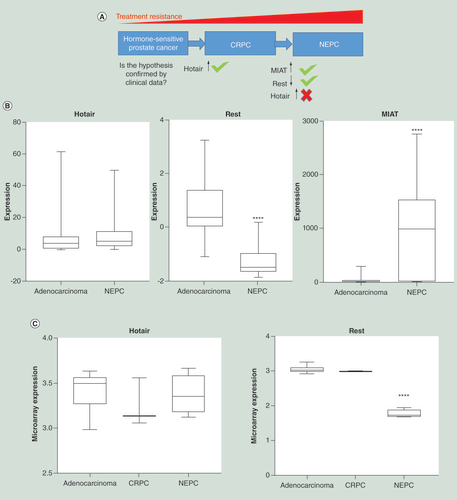Long noncoding RNAs (lncRNAs) are emerging as key players in several aspects of human pathophysiology [Citation4]. Upon transcription, lncRNAs fold in tridimensional structures and can interact with epigenetic effectors, signalling proteins and other macromolecules, thereby influencing a diverse range of cellular phenotypes. However, due to the limited information available on lncRNA function and expression profiles, it is sometimes difficult to define their roles in specific diseases.
HOTAIR is an oncogenic lncRNA, which was first discovered for its role in breast cancer metastasis [Citation3]. Successive studies have confirmed the oncogenic role of HOTAIR in other malignancies, including prostate cancer. As shown in , prostate malignancies can progress through three main stages: hormone-sensitive tumors, which are treatable by a combination of radiotherapy, surgery and hormonal therapy; castration-resistant prostate cancer (CRPC) which is resistant to conventional androgen deprivation therapy, but can be treated by more potent hormonal drugs (enzalutamide, abiraterone); neuroendocrine prostate cancer (NEPC), which is currently incurable. Clinical and experimental evidence indicates that the HOTAIR lncRNA drives the progression from androgen-sensitive to CRPC [Citation3].
(A) A unified model describing the role of HOTAIR, REST, and MIAT in the three main stages of prostate cancer progression. (B) Clinical samples from patients with prostate adenocarcinoma, and neuroendocrine prostate cancer (NEPC). REST is signficantly downregulated in NEPC vs adenocarcinoma (p < 0.0001). MIAT is signficantly upregulated in NEPC vs adenocarcinoma (p < 0.0001). (C) PDX models of prostate adenocarcinoma, castration resistant prostate cancer (CRPC), and neuroendocrine prostate cancer (NEPC). REST is signifiantly downregulated in NEPC vs adenocarcinoma and CRPC (<0.0001). (C) Data analysed by two-tailed t-test. Data analyzed by one-way analysis of variance with Tukey’s post-hoc test. All data analyzed using graphpad Prism 7 software.

We have previously shown that the lncRNA MIAT might be involved in a further step of prostate cancer progression: the transdifferentiation from prostatic adenocarcinomas to NEPC [Citation2]. Our analysis of clinical databases showed that MIAT expression is significantly higher in NEPC samples, compared with all other prostate cancer subtypes, and that MIAT upregulation is associated with worse prostate cancer prognosis. NEPC is the deadliest form of prostate cancer. Hence, understanding the mechanisms underpinning this transdifferentiation is of fundamental importance. For this reason, we are currently working on the functional characterization of MIAT and other lncRNAs that could be involved in NEPC.
A recent experimental paper claimed that the HOTAIR lncRNA also plays a pivotal role in NEPC transdifferentiation [Citation1]. The authors found that HOTAIR upregulation induced the expression of some NEPC markers in prostate cancer cells, and that HOTAIR expression was inhibited by the transcriptional repressor REST. Since REST is downregulated during the transition from CRPC to NEPC, the authors propose that REST silencing triggers HOTAIR expression in NEPC cells (). An analysis of clinical prostate cancer samples showed that HOTAIR expression is higher in CRPC, compared with hormone sensitive malignancies. Crucially, the authors did not compare the expression of HOTAIR in NEPC versus CRPC samples.
In light of this evidence, we sought to corroborate the role of HOTAIR in NEPC transdifferentiation by analyzing our patient-derived models and a clinically available dataset (CbioPortal, ‘Trento-Cornell-Broad 2016’). As shown in we found that, while REST is consistently downregulated in NEPC versus CRPC/adenocarcinoma samples, HOTAIR is expressed at very similar levels in the two groups. Notably, the clinical dataset confirmed our previous findings on MIAT, showing that this lncRNA is selectively upregulated in NEPC samples.
Based on this evidence, we propose that the protein REST plays a pivotal role in inhibiting NEPC transdifferentiation, but that this effect is not mediated by the HOTAIR lncRNA. We believe that further studies are needed to dissect the functional role of lncRNAs in NEPC.
Financial&competing interests disclosure
This article was partially supported by Cancer Research UK DDC project grant 22592. The authors have no other relevant affiliations or financial involvement with any organization or entity with a financial interest in or financial conflict with the subject matter or materials discussed in the manuscript apart from those disclosed.
No writing assistance was utilized in the production of this manuscript.
Additional information
Funding
References
- Chang YT , LinTP , TangJTet al. HOTAIR is a REST-regulated lncRNA that promotes neuroendocrine differentiation in castration resistant prostate cancer . Cancer Lett.433 , 43 – 52 ( 2018 ).
- Crea F , VenalainenE , CiXet al. The role of epigenetics and long noncoding RNA MIAT in neuroendocrine prostate cancer . Epigenomics8 ( 5 ), 721 – 731 ( 2016 ).
- Gupta RA , ShahN , WangKCet al. Long non-coding RNA HOTAIR reprograms chromatin state to promote cancer metastasis . Nature464 ( 7291 ), 1071 – 1076 ( 2010 ).
- Jain S , ThakkarN , ChhataiJ , Pal BhadraM , BhadraU . Long non-coding RNA: functional agent for disease traits . RNA Biol.14 ( 5 ), 522 – 535 ( 2017 ).
